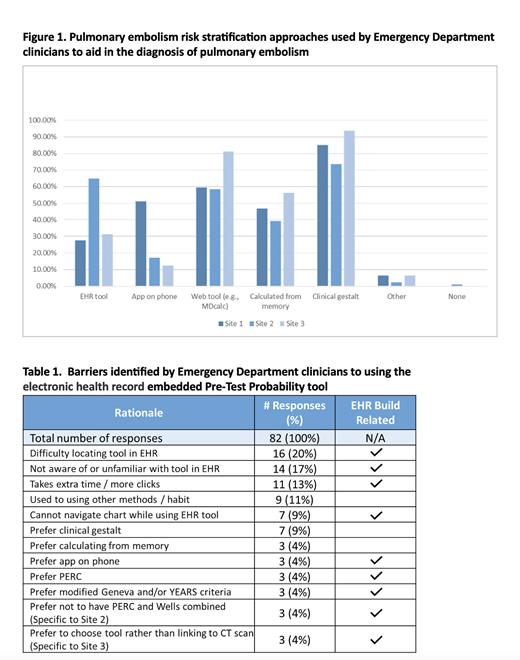Introduction
Pulmonary Embolism (PE) is a major cause of morbidity and mortality worldwide. Diagnosis is essential as untreated PE has a 30% mortality rate. Currently, computer tomography pulmonary angiogram (CTPA) is the standard of care to diagnose PE. However, this modality is expensive, exposes patients to radiation and increases risk of contrast induced nephropathy. Furthermore, only 5% of CTPAs performed are positive for PE signifying that many unnecessary tests are being performed. To address this gap, Pre-Test Probability (PTP) tools have been developed to safely exclude patients with low risk of PE and limit iatrogenic harm from over testing. Despite the tools being developed over 20 years ago, they are not widely available in electronic health record (EHR) systems and even when they are built in, uptake remains low.
Methods
Three large integrated health systems using Epic EHR systems across five states (MA, WI. MN, AZ, FL) built electronic PTP assessments into their EHR systems to safely exclude patients with low risk of PE and limit over testing. Two sites made the PTP optional, and one site made it a forced function (providers were forced to complete PTP prior to ordering CTPA unless a D-dimer result was present in the prior 48 hours). To assess the usability of these EHR tools, the team conducted a survey with ED clinicians across the three test sites. The survey was created to identify which PE risk stratification methods were employed by ED clinicians (EHR embedded PTP tool, apps on their phone, web applications like MDcalc, calculations from memory, or if they relied on clinical gestalt), and to identify barriers to using the EHR embedded PTP.
Results
Site 1 had 47 respondents, Site 2 had 94 respondents, and Site 3 had 16 respondents. Two key findings emerged from the survey (Figure 1). First, clinicians used a variety of risk stratification approaches and few of them documented their risk assessments in structured fields in the medical record. Second, clinical gestalt was the most used PE risk stratification approach, and this was true across all three test sites. In addition, the health system with a PTP prompt before clinicians could proceed with CTPA orders (Site 3) did not have a higher percentage of clinicians who reported using the EHR embedded tool than sites that did not prompt clinicians to fill in the PTP. Clinicians cited a variety of different barriers to using the EHR embedded PTP tool (Table 1).
Conclusion
While many clinicians indicated intermittent use of PTP criteria to aid in the diagnosis of PE, risk factors and scores from phone apps, web tools, and calculations from memory are unlikely to be documented in the patient's medical record, which means that they are not accessible to all members of the ED care team and cannot be used for electronic clinical quality measure. The biggest hurdles to increasing the use of structured PTP assessments in the ED setting to safely exclude PE and limit iatrogenic harm from over testing are (1) obtaining buy-in from ED clinicians that the PTP tools provide value over clinical gestalt, at least for a subset of patients who could most benefit, and (2) identifying best practices for incorporating PTP tools into EHR systems that make the tools easier to access and use 3) developing and implementing effective education and awareness programs around the PTP tools. This survey adds to the body of literature on PTP assessments in the ED setting and can help inform further research that is needed to continue to improve the diagnosis of PE.
Funding: This project is funded in part by the Gordon and Betty Moore Foundation through Grant GBMF10778 to the American Society of Hematology.
Disclosures
Rosovsky:Janssen: Consultancy, Other: Research funding is to my institution, Research Funding; Abbott: Consultancy; Dova: Consultancy; BMS: Consultancy; Pulmonary Embolism Response Team: Membership on an entity's Board of Directors or advisory committees, Other: President-Elect; Inari: Consultancy; Penumbra: Consultancy, Other: National Lead Investigator for STORM PE.


This feature is available to Subscribers Only
Sign In or Create an Account Close Modal